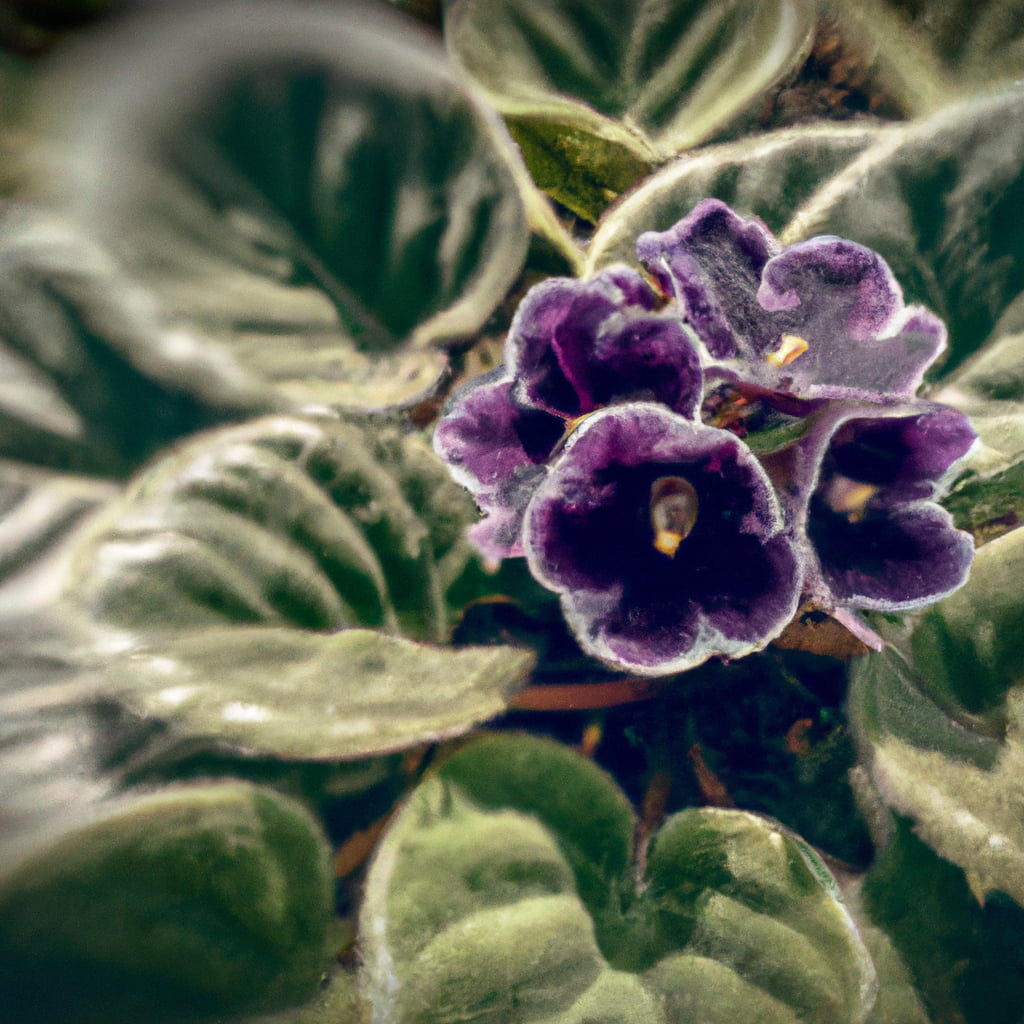Can African Violets thrive outdoors?
African Violets are known for their indoor beauty, but can they be planted and thrive outside? Yes, under specific conditions. It is essential to know the climate of the area where you intend to plant them. African Violets prefer a temperature range of 65-80°F and low humidity levels between 40% and 60%. Additionally, they require soil with good drainage and adequate water supply. In nature, African Violets grow in shaded areas, so planting them under direct sunlight may cause stress to the plants.
If properly taken care of, African violets can establish themselves thrivingly outdoors. However, they are sensitive to sudden changes in weather; hence regular monitoring is necessary. Placing them against walls or other plants can help regulate temperature and wind flow.
Interestingly, African Violet history can be traced back to East Africa’s Usambara Mountains. Baron Walter von Saint Paul first discovered them in 1892 while exploring Tanzania’s mountainous regions. They were initially cared for as houseplants in Germany’s grand gardens until their popularity spread worldwide due to their beauty and the multiple colors that they bloom into every year.
Before throwing your violets into the great outdoors, don’t forget to check the weather forecast and make sure Mother Nature isn’t just playing a cruel joke on you.
Factors to consider before planting African Violets outside.
Planting African violets outside requires careful consideration of several factors. The ideal location, soil type, and the level of shade or sunlight must be analyzed before planting. Additionally, environmental conditions such as temperature and humidity levels should also be taken into account. Subsequently, planting African violets outside can be an enriching experience when these variables are adequately addressed.
To ensure that your African violet thrives outdoors, choose a site with well-drained soil that is rich in organic matter while avoiding areas with waterlogged soils or standing water as these conditions can lead to root rot. Also, African violets need indirect light or partial shade; hence direct sunlight exposure can harm them. For optimal growth, determine the right pH range for the soil and supplement it with nutrients at suitable intervals.
You must consider exercising caution to protect your African violet from environmental changes such as extreme temperatures and strong winds since they weaken the plant’s immune system making it vulnerable to diseases. Moreover, periodically monitor changes in humidity levels since too much moisture attracts pests like spider mites while extremely dry air leads to leaf dehydration.
If you decide to plant African Violets outdoors, try container gardening rather than planting directly in the ground- containers will protect them from harsh weather conditions; use a high-quality potting mix specially formulated for flowering plants to provide sufficient aeration and drainage while regulating moisture retention. Maintaining adequate watering schedules – not too little nor too much – is essential for healthy growth.
Planting African Violets outside is like putting a ballerina in a mosh pit – it’s not recommended, but if you’re feeling daring, follow these steps.
Steps to plant African Violets outside.
African violets are delicate and require the right environment to thrive. Here’s how to properly plant them outside.
To start, dig a hole that is large enough for the African violet root ball. Gently remove the plant from its container and carefully loosen any compacted soil around the roots. Place the root ball in the hole and gently backfill with soil. Water the plant thoroughly, keeping the soil moist but not waterlogged.
- Dig a hole
- Remove from container
- Loosen compacted soil
- Backfill with soil & water
It’s important to note that African violets should not be planted directly in sunlight as it can scorch their leaves. They prefer bright indirect light, so planting them in an area where they receive morning sun and afternoon shade is ideal.
When planting African violets outside, it’s essential to ensure they’re planted in well-draining soil as they do not tolerate standing water.
Planting African violets outside can provide an excellent way to enjoy their beautiful blooms throughout the year while also enhancing your garden’s visual appeal.
Don’t miss out on adding these lovely plants to your outdoor space and follow these simple steps to plant them successfully.
Planting African violets outside is like trying to introduce a pampered indoor cat to the great outdoors – it can be done, but you’ll need to take some precautions.
Tips to ensure the success of planting African Violets outside.
African Violets can be planted outside, but it requires certain steps to ensure success. Before planting, choose a shady spot with well-draining soil and avoid direct sunlight. Use organic fertilizer and maintain even moisture levels. Deadhead regularly to promote blooming. Additionally, ensure protection from pests and extreme temperatures.
One unique detail is that African Violets don’t tolerate wet or compacted soil; hence the importance of well-draining soil. Another interesting fact is that the plant’s leaves are sensitive to water droplets, so it’s best to water at the base rather than on leaves.
Pro Tip: Mulching around the base of the plant helps retain moisture and prevent weeds.
Planting African violets outside may lead to more risks than rewards, like a game of Russian roulette but with plants.
Potential Risks when planting African Violets outside.
African violets flourish indoors but may not do well outdoors. The environment outside is different and unpredictable, making it difficult to cultivate African violet plants. Factors such as intense heat or cold, inconsistent weather patterns, and pest infestations are some potential risks that impact their growth.
Planting African violets requires adequate preparation. Choosing the appropriate location that provides proper sunlight exposure and the right soil conditions can improve their chances of success in an outdoor environment. Additionally, using the right potting mix and providing adequate nutrients will help them adapt to an unfamiliar terrain.
Furthermore, African violets are sensitive to over-watering or under-watering. Proper watering techniques include a gradual increase in watering amounts to acclimate them slowly to the outdoor environment. One can also use a bottom watering technique which reduces the occurrence of fungal diseases.
When planting African violet outside, it’s important to protect them from harsh environmental conditions such as frost or excessive heat by ensuring they get enough shade or moved indoors if necessary. Deadheading is another crucial factor in promoting healthy plant growth by removing spent blooms from the soil surface.
To conclude, planting African violets outside requires proper planning and care for success. They are sensitive plants that respond differently to subtle environmental changes. By following proper planting techniques and taking preventative measures when necessary one can successfully grow these beautiful plants outside with minimal risk factors affecting their growth patterns.
Planting African violets outside may not be the best idea, but hey, at least you’ll have something to blame when they die.
Conclusion.
African violets cannot survive outside due to their sensitivity to temperature fluctuations and direct sunlight. These plants thrive in warm, stable indoor environments with filtered light and high humidity levels. It is essential to keep them away from cold drafts and extreme temperatures.
While African violets cannot be planted outside, they can be grown in outdoor spaces like balconies or patios with protective coverings and the ideal growing conditions. Adequate watering, regular fertilization, and proper pruning are crucial for maintaining healthy plants.
To ensure the optimal growth of African violets, it is advisable to use well-draining soil mixes specifically designed for these plants. Also, regular repotting helps promote healthier root systems and prevents overcrowding.
Pro Tip: Avoid over-fertilizing African violets as this can lead to leaf burn and other plant health issues. Follow recommended feeding schedules carefully to avoid damage.
Frequently Asked Questions
1. Can African violets survive outdoors?
While African violets are typically regarded as indoor plants, they can survive outdoors under certain conditions.
2. What are the ideal growing conditions for African violets outside?
African violets require bright, filtered light and well-draining soil to thrive outdoors. They also need to be protected from extreme temperatures and direct sunlight.
3. Are African violets susceptible to pests and diseases outdoors?
Yes, African violets are vulnerable to common garden pests and diseases such as aphids, mealybugs, and root rot. Regular monitoring and a strict pest management plan are necessary to keep them healthy outdoors.
4. Do African violets need special care if grown outdoors?
Yes, African violets require regular watering, fertilization, and pruning when grown outdoors. They also need to be protected from frost and extreme heat.
5. Is it better to grow African violets in pots or plant them directly in the ground?
It is recommended to grow African violets in pots when grown outdoors, as this allows for easier protection from extreme temperatures and pests. However, they can also be planted directly in the ground with proper care and attention.
6. Can African violets be successfully grown outside year-round?
The success of growing African violets outside year-round depends on several factors, including climate, soil conditions, and protective measures. However, it is generally easier and more effective to grow them outside during the warmer months and move them indoors during colder periods.

A passionate gardener and founder of ForTheLoveOfGardeners.com. She shares her expertise to help you cultivate thriving gardens and find joy in the beauty of nature.
